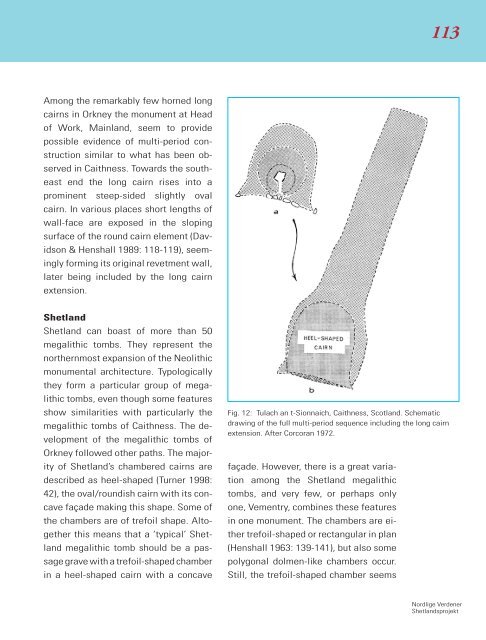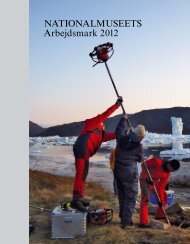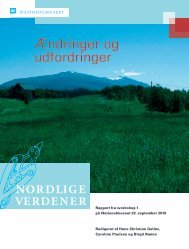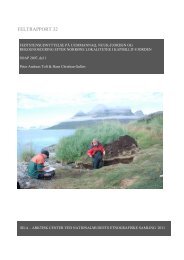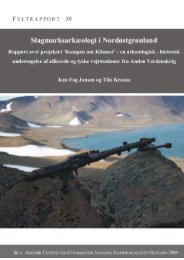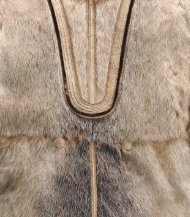The Border of Farming and the Cultural Markers - Nordlige Verdener
The Border of Farming and the Cultural Markers - Nordlige Verdener
The Border of Farming and the Cultural Markers - Nordlige Verdener
Create successful ePaper yourself
Turn your PDF publications into a flip-book with our unique Google optimized e-Paper software.
113<br />
Among <strong>the</strong> remarkably few horned long<br />
cairns in Orkney <strong>the</strong> monument at Head<br />
<strong>of</strong> Work, Mainl<strong>and</strong>, seem to provide<br />
possible evidence <strong>of</strong> multi-period construction<br />
similar to what has been observed<br />
in Caithness. Towards <strong>the</strong> sou<strong>the</strong>ast<br />
end <strong>the</strong> long cairn rises into a<br />
prominent steep-sided slightly oval<br />
cairn. In various places short lengths <strong>of</strong><br />
wall-face are exposed in <strong>the</strong> sloping<br />
surface <strong>of</strong> <strong>the</strong> round cairn element (Davidson<br />
& Henshall 1989: 118-119), seemingly<br />
forming its original revetment wall,<br />
later being included by <strong>the</strong> long cairn<br />
extension.<br />
Shetl<strong>and</strong><br />
Shetl<strong>and</strong> can boast <strong>of</strong> more than 50<br />
megalithic tombs. <strong>The</strong>y represent <strong>the</strong><br />
nor<strong>the</strong>rnmost expansion <strong>of</strong> <strong>the</strong> Neolithic<br />
monumental architecture. Typologically<br />
<strong>the</strong>y form a particular group <strong>of</strong> megalithic<br />
tombs, even though some features<br />
show similarities with particularly <strong>the</strong><br />
megalithic tombs <strong>of</strong> Caithness. <strong>The</strong> development<br />
<strong>of</strong> <strong>the</strong> megalithic tombs <strong>of</strong><br />
Orkney followed o<strong>the</strong>r paths. <strong>The</strong> majority<br />
<strong>of</strong> Shetl<strong>and</strong>’s chambered cairns are<br />
described as heel-shaped (Turner 1998:<br />
42), <strong>the</strong> oval/roundish cairn with its concave<br />
façade making this shape. Some <strong>of</strong><br />
<strong>the</strong> chambers are <strong>of</strong> trefoil shape. Altoge<strong>the</strong>r<br />
this means that a ‘typical’ Shetl<strong>and</strong><br />
megalithic tomb should be a passage<br />
grave with a trefoil-shaped chamber<br />
in a heel-shaped cairn with a concave<br />
Fig. 12: Tulach an t-Sionnaich, Caithness, Scotl<strong>and</strong>. Schematic<br />
drawing <strong>of</strong> <strong>the</strong> full multi-period sequence including <strong>the</strong> long cairn<br />
extension. After Corcoran 1972.<br />
façade. However, <strong>the</strong>re is a great variation<br />
among <strong>the</strong> Shetl<strong>and</strong> megalithic<br />
tombs, <strong>and</strong> very few, or perhaps only<br />
one, Vementry, combines <strong>the</strong>se features<br />
in one monument. <strong>The</strong> chambers are ei<strong>the</strong>r<br />
trefoil-shaped or rectangular in plan<br />
(Henshall 1963: 139-141), but also some<br />
polygonal dolmen-like chambers occur.<br />
Still, <strong>the</strong> trefoil-shaped chamber seems<br />
<strong>Nordlige</strong> <strong>Verdener</strong><br />
Shetl<strong>and</strong>sprojekt


